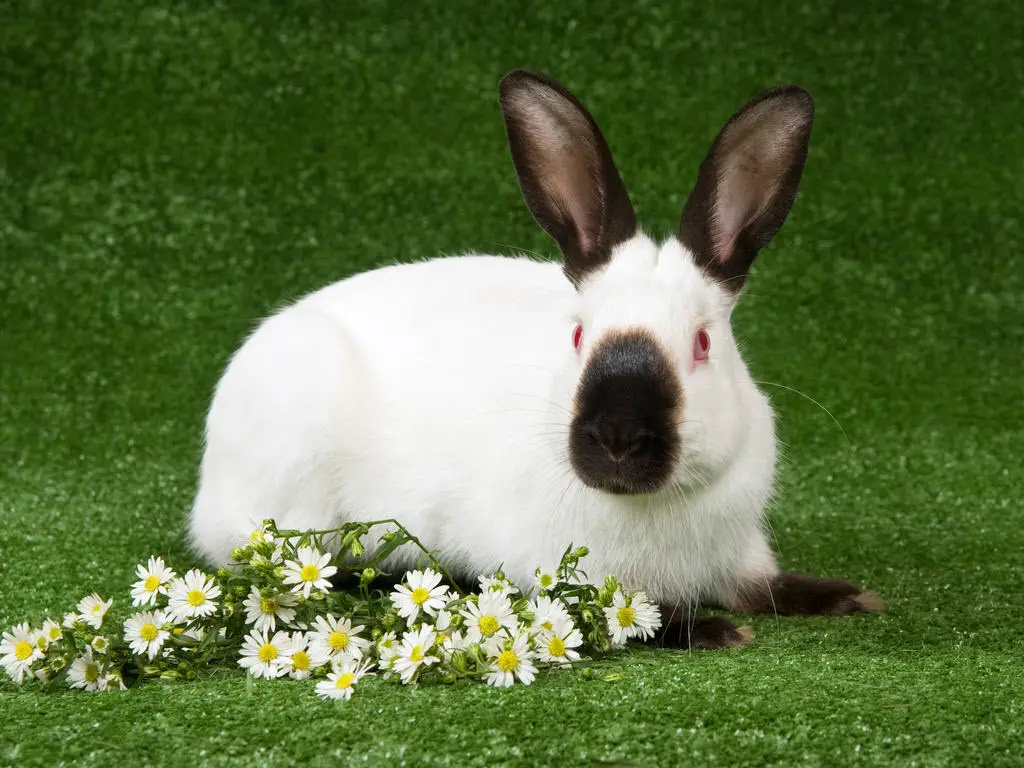Basic Appearance:
Himalayans are very unique rabbits. They are small rabbits, with very long, trim bodies. Their body color is white, with dark “points.” They have an egg-shaped marking on the nose, dark ears, legs, and tail. The points can be black, chocolate, blue, or lilac. Himalayans have red eyes.
History, Temperament, and Common Uses:
The Himalayan is one of the oldest rabbit breeds we have today. They have been around for so long, we are not sure when they first appeared, or where they originated. Though some say they are indeed from the Himalayan mountain area, records of these rabbits are found is several regions of the old world. Himalayans may have been brought to the United States during the Belgian Hare Boom in the early 1900’s. Himalayans are not only one of the most unique breeds recognized in the U.S., but also one of the oldest.
Himalayans are known for their easy-going and docile temperament. This coupled with their small size makes them an excellent choice for children wanting to start raising and showing rabbits.
Himalayans are popular both as show rabbits and as pets.
Grooming, Care, and Additional Notes:
Himalayan rabbits have short, flyback fur. They need very little grooming. Simply brushing them once a week, or going over their coat with damp hands should be enough to remove any loose hairs and keep your rabbits looking their best. They need more frequent grooming during a molt.
The color of a Himalayan is temperature sensitive. Cooler temperatures darken the points, warmer temperatures lighten them. The white body color can get dark spots on it if a Himie lies next to something cold such as a metal feeder in the wintertime.
Himalayans are the only breed with cylindrical body type, and are posed very differently from the other breeds. They should be stretched out to show their full body length. Remember they should have all for feet on the table, with their front feet even with their eyes.
Himalayan At A Glance…
Recognized Varieties:
Black, blue, chocolate, and lilac.
ARBA Body Type:
Cylindrical
Approximate Size:
2 1/2 to 4 1/2 pounds.
Important Things to Look for When Buying Show Stock:
A body that is long, narrow, and cylindrical when properly posed. A top line and side lines that are straight, showing no arch or taper. A Himalayan’s body should be round and firm, have good length, and be narrow, showing its cylindrical shape. They should have a long and “neat” head, with thin, erect ears. Ears should taper toward the tip and also have a neat appearance. Eyes should be bold and alert. Himies should have long, slender legs and feet, with well furred footpads and dark toenails. The tail should be held erect and straight. Look for flyback fur that is short, silky, fine, and even, and fitting close to the body. There should be some resistance to when stroked backwards.
It is important to note that because Himalayans have such a long, narrow body type they will not have a rounded hindquarter as most other breeds do. Roughness over the hindquarters is not penalized.
Himalayans should have markings in five places: nose, ears, tail, feet, and legs. The nose marking should be egg shaped and large, with the small end up. It should be well rounded and carry up between the eyes. The ears should be completely colored, and have a clean base, so they look like they were set on a white head. The feet and legs are to have the same color as the other markings, and the color is to carry as far as possible up the legs. The tail also should match the marking colors. All markings should be well defined and clear cut.
Things to Avoid:
Rabbits with short, close coupled type, or an arch or taper in the top or side lines. Heavy hips, large bone, or large rabbits. Fat rabbits or animals with pot bellies are faulted. A dewlap is a disqualification. Full, bulldog type head, or pinched muzzle. Thick ears, ears shaped like spoons, or ears that are spread apart. Unmatched toenails are a disqualification. Fur that is long, harsh, uneven, or hutch stained is a fault. Eye stains are a minor fault. Smut (dark color) is a disqualification on any useable part of the pelt, and white spots in any marking is a disqualification.
Markings that have stray white hairs, are not clean cut, are frosty, brassy, or are unequal.


